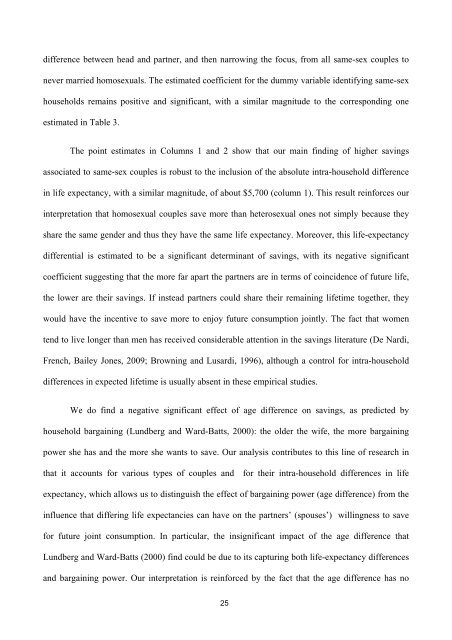Download PDF - Ivie
You also want an ePaper? Increase the reach of your titles
YUMPU automatically turns print PDFs into web optimized ePapers that Google loves.
difference between head and partner, and then narrowing the focus, from all same-sex couples to<br />
never married homosexuals. The estimated coefficient for the dummy variable identifying same-sex<br />
households remains positive and significant, with a similar magnitude to the corresponding one<br />
estimated in Table 3.<br />
The point estimates in Columns 1 and 2 show that our main finding of higher savings<br />
associated to same-sex couples is robust to the inclusion of the absolute intra-household difference<br />
in life expectancy, with a similar magnitude, of about $5,700 (column 1). This result reinforces our<br />
interpretation that homosexual couples save more than heterosexual ones not simply because they<br />
share the same gender and thus they have the same life expectancy. Moreover, this life-expectancy<br />
differential is estimated to be a significant determinant of savings, with its negative significant<br />
coefficient suggesting that the more far apart the partners are in terms of coincidence of future life,<br />
the lower are their savings. If instead partners could share their remaining lifetime together, they<br />
would have the incentive to save more to enjoy future consumption jointly. The fact that women<br />
tend to live longer than men has received considerable attention in the savings literature (De Nardi,<br />
French, Bailey Jones, 2009; Browning and Lusardi, 1996), although a control for intra-household<br />
differences in expected lifetime is usually absent in these empirical studies.<br />
We do find a negative significant effect of age difference on savings, as predicted by<br />
household bargaining (Lundberg and Ward-Batts, 2000): the older the wife, the more bargaining<br />
power she has and the more she wants to save. Our analysis contributes to this line of research in<br />
that it accounts for various types of couples and for their intra-household differences in life<br />
expectancy, which allows us to distinguish the effect of bargaining power (age difference) from the<br />
influence that differing life expectancies can have on the partners’ (spouses’) willingness to save<br />
for future joint consumption. In particular, the insignificant impact of the age difference that<br />
Lundberg and Ward-Batts (2000) find could be due to its capturing both life-expectancy differences<br />
and bargaining power. Our interpretation is reinforced by the fact that the age difference has no<br />
22

















